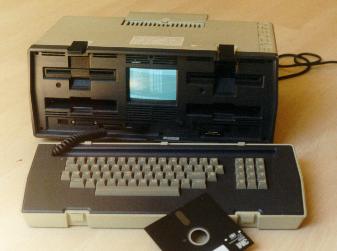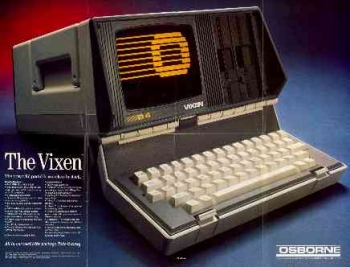


The great breakthrough in my writing and journalism career was acquiring a computer. In December 1982, I bought an Osborne 1 CP/M computer. It had an incorporated monitor (3.55" horizontal by 2.63") with a black and white display that was only forty characters wide. It had two floppy disks and 64 Kb of memory. It weighed 26.2 pounds so it was just barely "portable." It was really luggable. I took it back to Peru by shoving it under my airplane seat -- just barely. Because it look just like an oversized briefcase, I carried it passed the customs agent who did not even recognize it as a computer. If I had purchased a more traditional IBM compatible, I would have had more problems taking it to Peru.
 |
The Osborne was affordable, about $1,800, that I financed with a loan from my parents. It paid for itself within a year because I really pushed my free-lancing. Since the computer was sold with a complete set of applications, including WordStar word processor, I started writing immediately. I also had an Epson printer.
What did the new writing medium mean to me?
The one drawback was learning how to do simple file operations with CP/M. A couple of books helped me, and that started me on the road of self-enlightenment through perennial trouble-shooting. Between the complexities of command-line operating systems and WordStar formatting, I lost my fear of computers.
In 1986, I upgraded to an Osborne Vixen, which had 7" diagonal amber monitor 80-column, 24-line display and a 8x10 dot characters. It was a lot easier on the eyes and a full-width page could fit on a screen. It was lighter, more compact and a fun little computer to use -- basically, what the Osborne 1 should have been and cheaper than an IBM. But the market (IBM and Microsoft) had overtaken Osborne and the CP/M niche.
 |
The Osborne Corporation had been swamped by initial demand for its product. The company could not grow fastest enough. Then it made the mistake of announcing its new product, the Executive, without being able to deliver it. The samething is happening today with Palm. Demand for the old Osborne dried up. It sought bankruptcy relief. It brought out the Vixen, then tried to switch over to IBM compatibles. Finally, it folded. Osborne disappeared from the US computer scene.
IN 1986, I took the next step in electronic media and bought a Hayes 300 bps modem to deliver stories by phone. In those days, you had to hardwire your cable to the wall outlet, if you were lucky enough to have a phone. The modem program was a command-line utility with no manual and little feedback. I remember the author, Ward Christensen, and sweating over his geeky documentation. I usually delivered my stories with a international long distance call to the newspaper or magazine.
Before then, I had to spend long hours in a news agency office waiting to get on a spare teletype machine to hammer out my stories on punch ribbons that were then fed into a telex machine. I spent several all nighters locked in the Reuters office in downtown Lima, with the doors locked so that I could not get out or anyone get in. Not a very stimulating place. With a modem, I could spend more time at home with a family and writing. Another boost for my productivity and income. In addition, I could continue working on a story until much closer to my deadline, which meant that the quality improved and I could include late breaking news.
In 1988, I got a NEC PC portable because I was afraid of getting stranded with an operating system that was headed for extinction. I held onto the 286 until 1993, and my sister used for another four years. I delivered my first story in 1986. Those were the days when you used a command-line program and had to hard wire the modem into the phone line. The chirping of a modem speaker is music to my ear.
The main drawback was electricity. At the end of the 1980s, Sendero was increasing its pressure on the government, Peruvian elites and Lima. One tactic was blowing down power pylons and plunging Lima into a blackout. Combine that with a draught and Garcia administration mismanagement and they translated into power rationing for most of 1989 and 1990. I used to write after 8 PM and continued well into the morning. I delivered my news stories via modem praying that the electricity would not be interrupted.
I mention all this history because I have started using a Handspring Visor PDA and was struck by the similarities between my old Osborne and my handheld. If anything, my Visor has better resolution than the Osborne. They both have restrictions on the muscles of the programs that they can use.
I also started working with outliners then, starting with Thinktank and then getting Ready. In 1990, I bought GrandView. I mention this because I am once again using outliners, but on a Palm PDA. It seems that outliners are making a recovery after having dropped off the software scene for almost a full decade. I certainly feel drawn to an outliner as a thinking tool.
I had a short exposure to WordPerfect, jumping into MS Word for DOS in 1993 because it was the office standard at CIP, and then came the Windows 95 revolution.